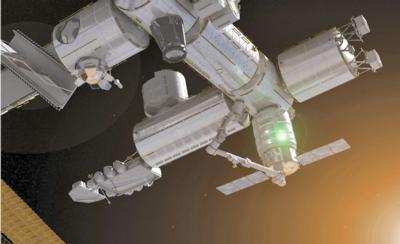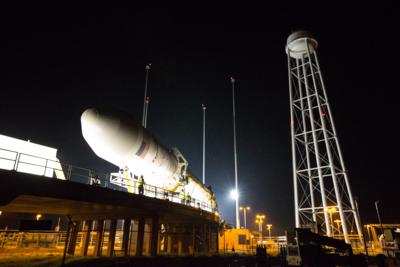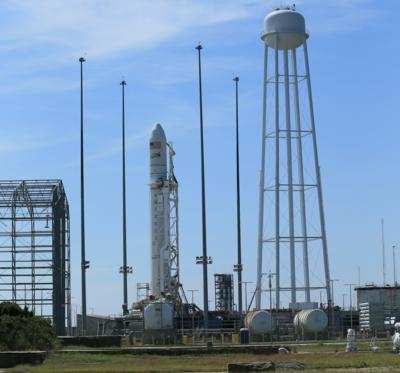Sun, Sep 15, 2013
Cygnus To Be First Spacecraft Launched To The Orbiting Laboratory From Virginia
Orbital Sciences Corp. of Dulles, Va., will postpone by at least 24 hours the launch of its Antares rocket and Cygnus spacecraft on a demonstration mission to the International Space Station from NASA's Wallops Flight Facility in eastern Virginia.

The new launch window is targeted for Wednesday, Sept. 18 between 10:50 to 11:05 a.m. EDT from the Mid-Atlantic Regional Spaceport Pad-0A at Wallops. Rendezvous with the space station remains scheduled for Sunday, Sept. 22.
The postponement is due to a combination of Friday’s poor weather, which delayed roll-out of Antares to the launch pad, and a technical issue identified during a combined systems test held Friday night involving communications between ground equipment and the rocket’s flight computer. The problem has been identified and corrected. The teams are working to understand why the problem occurred.
The company's Cygnus cargo carrier will be the first spacecraft launched to the orbiting laboratory from Virginia. The spacecraft will deliver about 1,300 pounds (589 kilograms) of cargo, including food and clothing, to the Expedition 37 crew aboard the space station. Future flights of Cygnus will significantly increase NASA's ability to deliver new science investigations to the nation's only laboratory in microgravity.

Orbital is the second of NASA’s two partners taking part in the agency's COTS program. The goal of this program is to develop safe, reliable, and cost effective cargo transportation systems. Orbital began its work in 2008. Following a successful demonstration mission, the company is poised to begin regular resupply missions. The other partner, Space Exploration Technologies (SpaceX), began its work in 2006, and after a successful test flight in 2012, began flying regular cargo missions to the space station.
During Cygnus' flight to the station, several of the spacecraft's systems and capabilities will be tested. After the space station flight control team has verified the results of these objectives, the spacecraft will be cleared to approach the station several days after launch. Cygnus will undergo more tests and maneuvers and ultimately will arrive beneath the outpost, where astronauts on board will use the station’s arm to capture the craft. They then will install it on the bottom side of the station’s Harmony module.

More News
How To Get A Story On Aero-TV News/Feature Programming How do I submit a story idea or lead to Aero-TV? If you would like to submit a story idea or lead, please contact Jim Campbel>[...]
From 2011 (YouTube Edition): Aviation's Greatest Living Legend Talks About His Life In Aviation (Part 5, Final) ANN is pleased to offer you yet another snippet from the public conv>[...]
“All Air Traffic Controllers must get back to work, NOW!!! Anyone who doesn’t will be substantially ‘docked. For those Air Traffic Controllers who were GREAT PATR>[...]
Aero Linx: American Navion Society Welcome to the American Navion Society. Your society is here to support the Navion community. We are your source of technical and operating infor>[...]
Glideslope Intercept Altitude The published minimum altitude to intercept the glideslope in the intermediate segment of an instrument approach. Government charts use the lightning >[...]
 ANN FAQ: Contributing To Aero-TV
ANN FAQ: Contributing To Aero-TV Classic Aero-TV: Bob Hoover At Airventure -- Flight Test and Military Service
Classic Aero-TV: Bob Hoover At Airventure -- Flight Test and Military Service Aero-News: Quote of the Day (11.12.25)
Aero-News: Quote of the Day (11.12.25) ANN's Daily Aero-Linx (11.12.25)
ANN's Daily Aero-Linx (11.12.25) ANN's Daily Aero-Term (11.12.25): Glideslope Intercept Altitude
ANN's Daily Aero-Term (11.12.25): Glideslope Intercept Altitude





